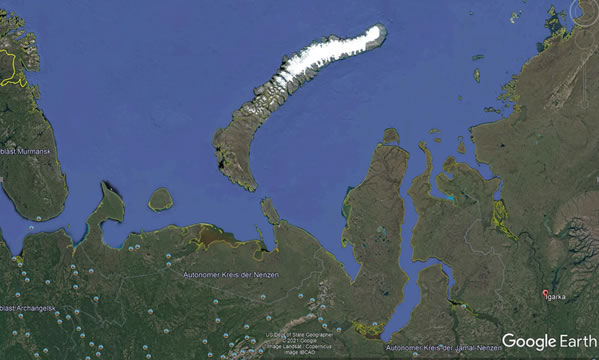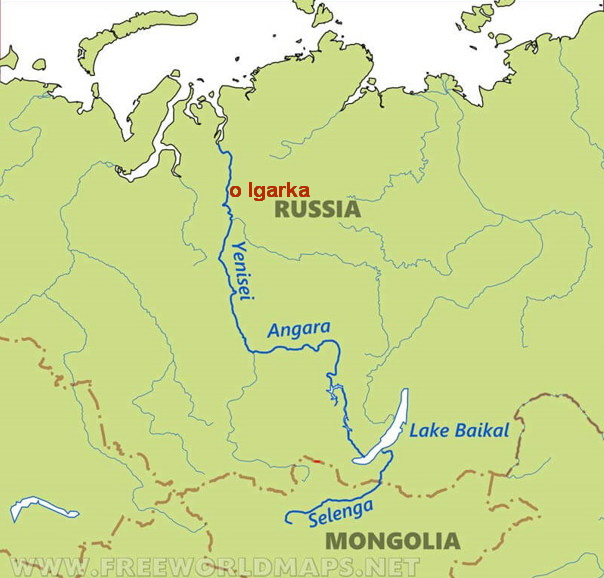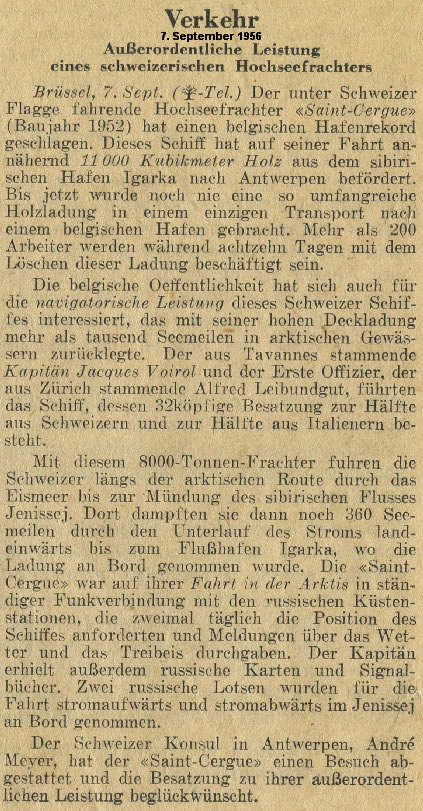
This general cargo steamer was built by the shipyard William Gray & Company Ltd. West Hartlepool on the east coast of England. On 13.12.1951 the steamer was launched under the name PAYSANDU for Leado S.A. Montevideo, Uruguay, a company presumably controlled by Suisse-Atlantique. However, on 07.03.1952 she was commissioned as ST. CERGUE for Suisse-Atlantique Société de Navigation Maritime S.A. Lausanne and registered in Bâle (Basel) under the Swiss flag (official No.: 42, call sign: HBFD). In 1956 she was transferred to the owner company Helica S.A. Geneva with the same name and without a change of flag. The crew of 32 was approximately half Swiss and half Italian.
The ST. CERGUE was a 'steamer' with a triple-expansion reciprocating steam engine, which was equipped with a Bauer-Wach exhaust turbine to improve efficiency and thus reduce fuel consumption. During manoeuvring, the steam was channelled directly into the condensator by means of a transfer flap, as a steam turbine cannot run backwards. The steam engine had an open crankcase.

Lay-out sketch of a Bauer-Wach Exhaust steam turbine
The steam boilers were located in an elevated position within the machinery space in order to conserve space and were thus referred to as deck boilers, hence the large and high deck house aft of the funnel.
The ST. CERGUE was engaged in worldwide tramp shipping and, according to the voyage cards, sailed in her first year to Australia, via Honolulu to Vancouver, then Argentina, the West Indies and South Africa. In August of each year (1955, 1956, 1957 and 1959) she made a total of 4 voyages to Igarka in Siberia to load lumber and bring it to Western Europe.
On a voyage from Murmansk to Brunsbüttelkoog under the command of the Swiss captain Jacques Voirol, the vessel ran aground on rocky ground on Monday, 31.10.1955 near the island of Uttorgflesa (between Lofoten Islands and Trondheim). The accident occurred after lunch in a heavy snowstorm, despite the engine telegraph being set to slow speed and a pilot was on board, although it should be mentioned that there was probably no radar installed on the vessel. The vessel had grounded onto rocks by the stem and thus water ingresses occurred to the fore-peak, forward ballast tank and cargo hold No.: 1.
At around midnight, the salvage tug PARAT reached the ship and the first towing attempts began, but without success. In the afternoon, the diver from the tug inspected the foreship, the hull was badly dented and it seemed that the water was penetrating through the numerous leaking rivets.
Late in the evening of 01.11.1955 the second tug SALVAGE appeared and again one day later the third tug, the DRAUGEN, arrived. In the meantime, the crew, together with the salvage crews, began
to jettison cargo overboard. The grounding report does not say what kind of cargo was on board, but it must have been grain or other bulk material, because the report says that drums and a grab from one of the tugs were in use. It is also important to mention, that on the second day, customs officials arrived by launch from Brömöysund to seal the bonded store.
Finally, on the fourth day, Thursday 03.11.1955, the three tugboats succeeded with combined force to free the steamer. The ST. CERGUE shifted to Berg-i-Helgeland and anchored there in the evening. After some emergency repairs, the vessel was able to continue her voyage and permanent repairs were carried out in a dry dock in Emden (see also attached grounding report and the photos).
On 28.04.1956 the ST. CERGUE left Nordenham, FRG in ballast to sail to Montreal. This subsequent voyage across the North Atlantic with Capt. Jacques Voirol in command was by all accounts extremely rough, the vessel encountering high seas and strong winds to the extent that the vessel was very much shaken up and tossed about. Upon arrival in Montreal the captain deposited a manifest before the court in order to indemnify himself against any damage to the ship. The incident is also recorded on the corresponding voyage card (see also attached manifest).
Sold to Bharat Line Ltd. Bombay on 12.09.1960 and handed over to the buyers in Bombay. Renamed BHARATJAL and registered under Indian flag in Bombay (official No.: 1021, call sign VWQC). The shipping press reported proceeds from the sale of 260'000.- GBP. After 13 years under the Indian flag, the ship was scrapped in Bombay in the second quarter of 1973.
Sources:
- Capt. Jacques Voirol
- Georges Haller, LR-Surveyor
- LR-Voyage Cards
SwissShips, MB, HPS, JTA, May 2021
![]()
Additional information and stories
Igarka, Siberia
The ST. CERGUE sailed to Igarka in the years 1955 to 1959, always in the month of August, September, when the Yenisei River is ice-free. Igarka is about 360 nautical miles upriver, which is almost twice the distance than on the better known Mississippi to Baton Rouge. Another company ship, the NYON also sailed to Igarka several times. Dictator Joseph Stalin died in March 1953, but still a cold war mentality prevailed in the Moscow Kremlin and the world was divided into East and West. No one, especially tourists, were allowed to visit Siberia, the few who normally got to know Siberia were German prisoners of war and political prisoners.

Igarka, on the Yenisei river

Igarka, on the Yenisei river
Igarka, a settlement of about 15,000 inhabitants founded in 1929, it had sawmills and a small harbour to load ocean-going ships with sawn timber for export. Stalin had utilised forced labour to build the "Polar Circle Railway", which ended in Igarka in the east. This railway was never completed and only parts of it are still in operation today. Even a naval base was planned in Igarka, but both projects were stopped after Stalin's death. From 1975 to 1980, Igarka experienced its heyday, about 1,200,000 m3 of timber per year were exported, making it the second largest timber port in the Soviet Union. A small airfield, located on an island, offers flight connections to Krasnoyarsk, Norilsk and Surgut. Thus, it is fair to say that these voyages by a foreign vessel to Igarka were something special at the time.
Captain Jacques Voirol made the voyage in August 1956, together with his first officer Alfred Leibundgut, to load sawn timber for Antwerp (see also the attached newspaper report). At Murmansk, a boat brought Soviet nautical charts; on the return trip, these charts had to be handed back in Murmansk. At that time, these nautical charts were still highly secret and could not be brought to the “evil” West.

Newspaper report on the Igarka voyage from the archives of Captain J. Voirol
At that time, water depths were indicated in fathoms and feet on the mainly British nautical charts (Admiralty charts), but also on other western charts.
1 fathom = 6 feet = 1,8288 m (or about 1/1000 nautical mile)
This circumstance was not noticed by the navigators on the ST. CERGUE and almost caused the steamer to run aground. With this unusual information in metres, the water depth was of course reduced almost half and it could have had a disastrous result. Admiralty charts were only converted to the metric system at beginning of the seventies, when the United Kingdom changed to SI-units. During the river passage pilots were on board.
We have posted a personal report by Emil Gremaud about Igarka on the first NYON, which visited this port three times.
SwissShips, HPS, JTA, May 2021